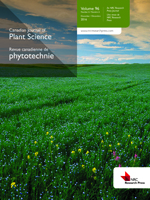Guan, Z.-j., Guo, B., Huo, Y.-l., Guan, Z.-p., Dai, J.-k. and Wei, Y.-h. 2012. Short Communication: Organogenesis and somatic embryogenesis in callus derived from HBsAg-transgenic tomato mutant. Can. J. Plant Sci. 92: 747-756. In the process of hepatitis B surface antigen (HBsAg) gene transformation, a transgenic cherry tomato (Lycopersivon esculentum Mill.) mutant N244 was occasionally obtained. Based on its obvious variation in ploidy and phenotypic characteristics, morphogenesis and development in the mutant in vitro were studied by cytological analysis and ultrastructural examination. The adventitious shoot primordia first emerged in the mutant N244 leaf explants after 14 d of culture, and the somatic embryo pathway developed after 35 d. Transmission electron microscopy and scanning electron microscopy further indicated that during the explant's development, there were significant changes in morphology and quantity of some organelles in N244 callus cells. On the 7th day of culture, there was little cytoplasm and few organelles, except for a large number of dense lipid bodies in the mutant callus cells. In the later stage, the changes in chloroplasts, Golgi bodies and mitochondria showed obvious difference between N244 callus cells and the control. In addition, changes in physiological indexes (growth rate, soluble protein content, and antioxidant enzyme activities) at different development stages further revealed morphogenic variation of organogenesis and somatic embryogenesis in N244 callus. The growth rate of the mutant N244 was less rapid than that of the control during its callus differentiation, and the soluble protein content of N244 callus decreased from the explant's cultivation stage until the 28th day of culture. The mutant N244 had distinct differences in variation tendency of superoxide dismutase, catalase and peroxidase activities compared with the control at every stage of callus development. These findings provide the first report of simultaneous shoot organogenesis and somatic embryogenesis of transgenic mutant and help us to understand the development mechanism of transgenic plant mutant in vitro.
How to translate text using browser tools
1 July 2012
Short Communication: Organogenesis and somatic embryogenesis in callus derived from HBsAg-transgenic tomato mutant
Zheng-jun Guan,
Bin Guo,
Yan-lin Huo,
Zheng-ping Guan,
Jia-kun Dai,
Ya-hui Wei
ACCESS THE FULL ARTICLE
It is not available for individual sale.
This article is only available to subscribers.
It is not available for individual sale.
It is not available for individual sale.

Canadian Journal of Plant Science
Vol. 92 • No. 4
July 2012
Vol. 92 • No. 4
July 2012
cal
Callus
cherry tomato
embryogenèse somatique
mutant
mutant
organogenèse




